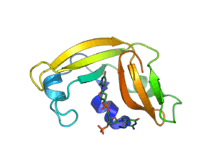Ranpirnase
| Ranpirnase | |
|---|---|
 Crystallographic structure of ranpirnase in complex with RNA.[1] | |
| Identifiers | |
| Organism | |
| Symbol | n/a |
| PDB | 2I5S |
| UniProt | P85073 |
| Other data | |
| EC number | 3.1.27 |
Ranpirnase is a ribonuclease enzyme found in the oocytes of the Northern Leopard Frog (Rana pipiens). Ranpirnase is a member of the pancreatic ribonuclease (RNase A) protein superfamily and degrades RNA substrates with a sequence preference for uracil and guanine nucleotides. Along with amphinase, another leopard frog ribonuclease, ranpirnase has been studied as a potential cancer treatment due to its unusual mechanism of cytotoxicity tested against tumor cells.[2]
Ranpirnase was originally discovered by scientists at TamirBio, a biotechnology company (formerly Alfacell Corporation), where it was tested in preclinical assays[3] and in clinical trials under the name Pannon or Onconase, respectively. The mechanism of action of ranpirnase tumor-selective cytotoxicity has been attributed to the RNA interference pathway, potentially through cleaving siRNA molecules;[4] to cleavage of transfer RNA;[2] and to interference with the NF-κB pathway.[5] Despite early indications of promise as a mesothelioma treatment,[6][7][8] and an orphan drug status designation from the United States Food and Drug Administration in 2007,[9] the Phase III clinical trial for this indication did not demonstrate statistical significance against primary endpoints.[10] Currently (as of May 2017) Ranpirnase is in Phase I clinical study for treatment of anogenital warts.[11]
References
- ↑ Lee JE, Bae E, Bingman CA, Phillips GN, Raines RT (January 2008). "Structural basis for catalysis by onconase". Journal of Molecular Biology. 375 (1): 165–77. doi:10.1016/j.jmb.2007.09.089. PMC 2151974. PMID 18001769.
- 1 2 Ardelt W, Shogen K, Darzynkiewicz Z (June 2008). "Onconase and amphinase, the antitumor ribonucleases from Rana pipiens oocytes". Current Pharmaceutical Biotechnology. 9 (3): 215–25. doi:10.2174/138920108784567245. PMC 2586917. PMID 18673287.
- ↑ Darzynkiewicz Z, Carter SP, Mikulski SM, Ardelt WJ, Shogen K. Cytostatic and cytotoxic effects of Pannon (P-30 Protein), a novel anticancer agent.Cell Tissue Kinet. 1988 May;21(3):169-82. PMID 3224365
- ↑ Zhao H, Ardelt B, Ardelt W, Shogen K, Darzynkiewicz Z (October 2008). "The cytotoxic ribonuclease onconase targets RNA interference (siRNA)". Cell Cycle. 7 (20): 3258–61. doi:10.4161/cc.7.20.6855. PMC 2586937. PMID 18927512.
- ↑ Nasu M, Carbone M, Gaudino G, Ly BH, Bertino P, Shimizu D, Morris P, Pass HI, Yang H (May 2011). "Ranpirnase Interferes with NF-κB Pathway and MMP9 Activity, Inhibiting Malignant Mesothelioma Cell Invasiveness and Xenograft Growth". Genes & Cancer. 2 (5): 576–84. doi:10.1177/1947601911412375. PMC 3161417. PMID 21901170.
- ↑ Costanzi J, Sidransky D, Navon A, Goldsweig H (2005). "Ribonucleases as a novel pro-apoptotic anticancer strategy: review of the preclinical and clinical data for ranpirnase". Cancer Investigation. 23 (7): 643–50. doi:10.1080/07357900500283143. PMID 16305992.
- ↑ Mikulski SM, Costanzi JJ, Vogelzang NJ, McCachren S, Taub RN, Chun H, Mittelman A, Panella T, Puccio C, Fine R, Shogen K (January 2002). "Phase II trial of a single weekly intravenous dose of ranpirnase in patients with unresectable malignant mesothelioma". Journal of Clinical Oncology. 20 (1): 274–81. doi:10.1200/JCO.2002.20.1.274. PMID 11773179.
- ↑ Vogelzang NJ, Rusthoven JJ, Symanowski J, Denham C, Kaukel E, Ruffie P, Gatzemeier U, Boyer M, Emri S, Manegold C, Niyikiza C, Paoletti P (July 2003). "Phase III study of pemetrexed in combination with cisplatin versus cisplatin alone in patients with malignant pleural mesothelioma". Journal of Clinical Oncology. 21 (14): 2636–44. doi:10.1200/JCO.2003.11.136. PMID 12860938.
- ↑ Waknine, Yael. "New FDA Orphan Drugs: Gestiva, Onconase, Aerosolized Ciprofloxacin". Medscape. Retrieved 2 February 2015.
- ↑ "Alfacell Annual Report 2009" (PDF). Retrieved 2 February 2015.
- ↑ Squiquera L, Taxman DJ, Brendle SA, Torres R, Sulley J, Hodge T, Christensen N, Sidransky D. Ranpirnase eradicates human papillomavirus in cultured cells and heals anogenital warts in a Phase I study. Antivir Ther. 2017 Jan 25. doi: 10.3851/IMP3133. PMID 28121292.